- AI Fire
- Posts
- 🤔 Could You Run An AI Business Alone? This Method Shows You How
🤔 Could You Run An AI Business Alone? This Method Shows You How
Forget AI theories. This is a breakdown of a real solo business. Learn the exact tools and workflow that built a profitable print-on-demand store.

What's the biggest thing holding you back from starting an AI-powered business? |
Table of Contents
You've probably seen plenty of videos with promises of making money quickly with AI. But this article offers a completely different perspective. This isn't just theory - it's a proven method, based on a real one-person AI business that can generate significant income.

This successful business model is a print-on-demand clothing store on Etsy, focusing on designs for lovers of specific dog breeds. Instead of selling generic "dog mom" t-shirts, this store creates clever designs for distinct breeds like Huskies, Golden Retrievers, and French Bulldogs. The best part is that the entire process, from design ideation to store optimization, is powered by AI tools.
If you're tired of promises without proof, this article will show you exactly how to replicate that proven system. You'll learn the specific tools, workflows, and strategies that turned a simple idea into a profitable business.
Step 1: Find A Real Problem To Solve (Don't Just Copy Others)

This is where most people go wrong: they try to copy a successful business exactly. But think about it: if customers see two stores selling identical products, one with many positive reviews and one that's brand new, who do you think they'll choose?
The key is to find what marketers call "a gap in the market." This means identifying something that people want that either doesn't exist yet or could be done much better.
How to Find Your Gap

The creator in the story found their gap simply by browsing Etsy and noticing something was missing. While there were plenty of general dog-themed shirts, there were very few designs for specific breeds like Huskies or German Shepherds. This was an unmet need.
Use AI as Your Brainstorming Partner
Instead of asking ChatGPT for generic business ideas, try a smarter approach. You need to guide the AI to ask questions that spark ideas from your own experiences and observations.
Try this prompt:

"Act as a market research analyst. Your task is to help me find a potential business idea by asking me a series of questions. These questions should focus on helping me identify products, services, or content that I or people I know want, but which don't currently exist or aren't very good. Please start with the first question."
This approach is much more effective because it forces you to think deeply about real problems around you. Your answer to each question will lead the AI to ask deeper, more specific follow-up questions, helping you uncover unique ideas.
You can also modify the prompt to focus on the people around you:

"Imagine you are a startup consultant. Ask me 5 questions to help me analyze the frustrations or desires of my friends, family, or colleagues. The goal is to find a product or service that could solve those problems better than the current solutions on the market."
Real-World Examples of Filling a Gap:
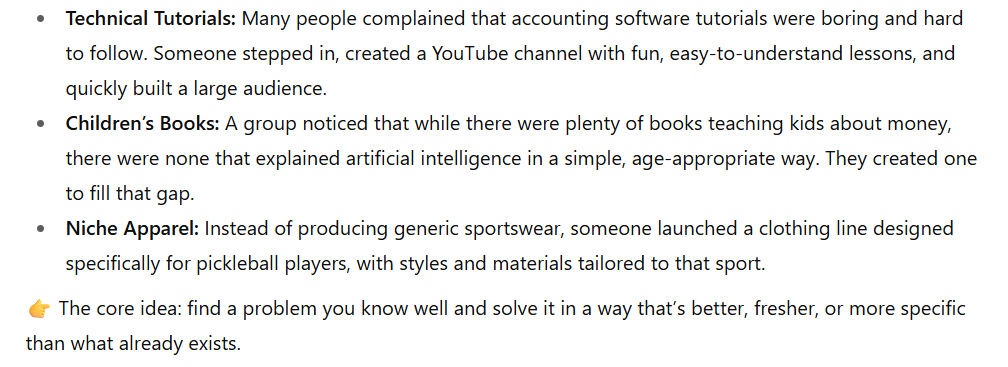
Technical Tutorials: Someone noticed their friends always complained that accounting software tutorials were dry and hard to follow. He created a YouTube channel with lively, more accessible tutorials and quickly attracted a large audience.
Children's Books: During a brainstorming session, a group of friends realized that there were many books teaching kids about money management, but no books explaining artificial intelligence in a simple, age-appropriate way.
Niche Apparel: Instead of selling generic sportswear, someone created a clothing line specifically for pickleball players, with designs and materials suited for that sport.
The key is to pick a problem you genuinely understand and feel confident you can solve better than anyone else.
Learn How to Make AI Work For You!
Transform your AI skills with the AI Fire Academy Premium Plan - FREE for 14 days! Gain instant access to 500+ AI workflows, advanced tutorials, exclusive case studies and unbeatable discounts. No risks, cancel anytime.
Step 2: Build Your Custom AI Workflow
Once you know what problem you're solving, you need to build an AI workflow. This is simply a series of tools working together to achieve your final goal. Think of it as an assembly line, where each AI tool handles a specific part of the process.
Example: Workflow for a Print-on-Demand Clothing Store
Slogan Ideation: Use ChatGPT to generate slogans, funny messages, and unique text related to dog breeds.
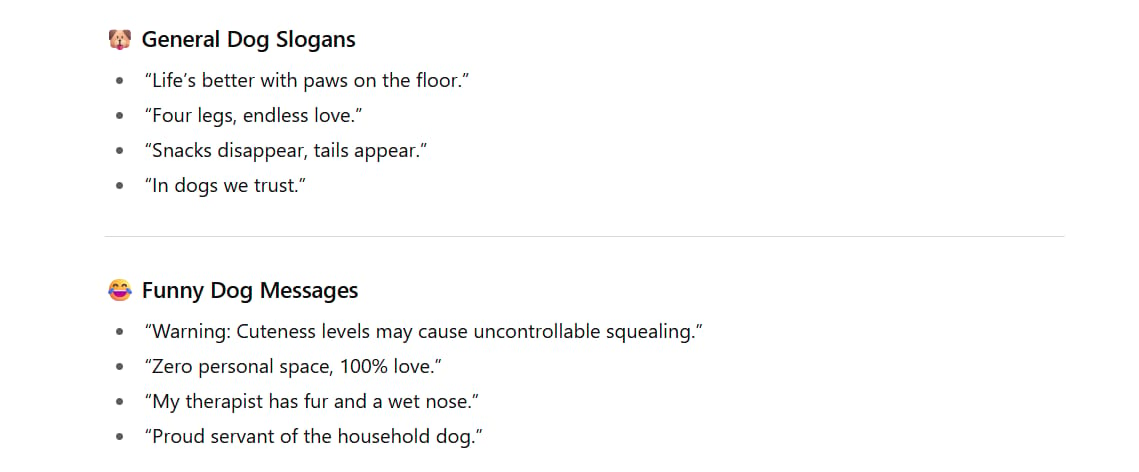
Image Creation: Use Midjourney to generate high-quality illustrations and graphics based on the ideas.

Final Design: Use Canva to combine the text and images into a complete, print-ready design.
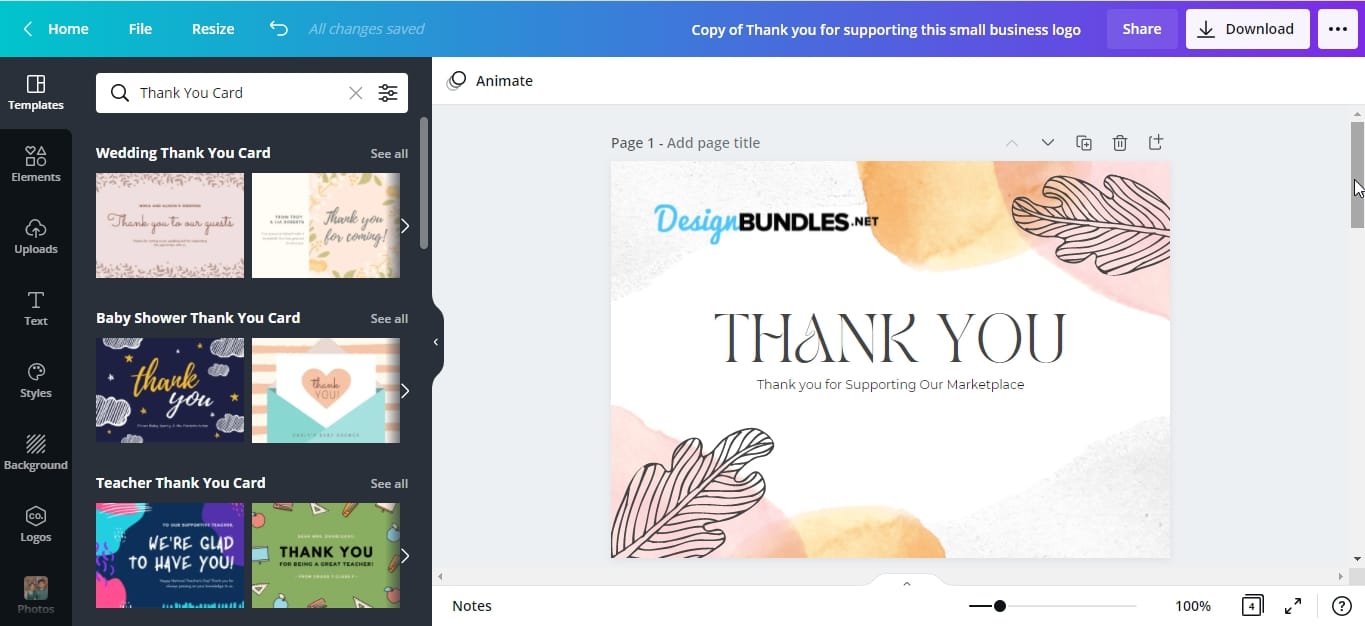
Production and Sales: Upload the design to print-on-demand platforms like Printify or Printful, which connect to your Etsy store.

Example: Workflow for a Children's AI Book
If you wanted to create a children's book about AI (similar to those popular money books for kids), your workflow might look like this:
Story Writing: Use Claude to write the story's content with language appropriate for young children, ensuring it's both educational and engaging.

Illustration: Generate illustrations for the story using AI art tools like Leonardo AI.

Layout and Design: Use design tools like Canva or Adobe InDesign to professionally combine the text and images.
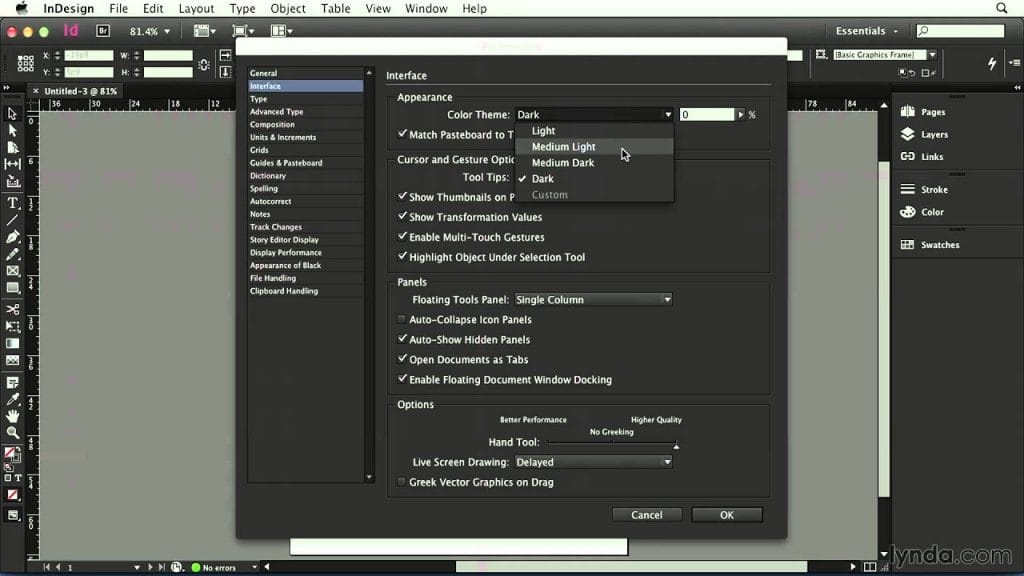
Publishing: Upload the book to a platform like Amazon KDP to sell and generate passive income.

How to Build Any Workflow
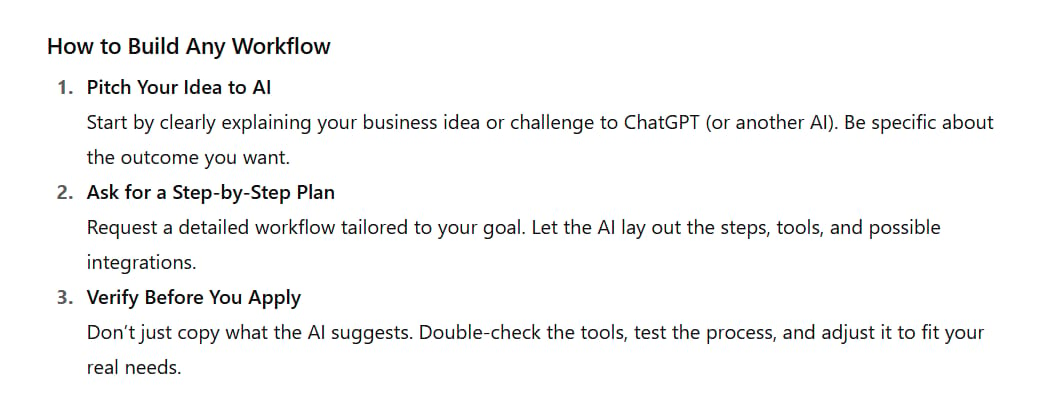
Present Your Idea to an AI: Clearly explain your business idea to ChatGPT or a similar AI.
Request a Workflow: Ask it to create a step-by-step AI workflow for your specific goal.
Don't Just Rely on AI's Suggestions: Don't blindly trust the tools the AI recommends. Do your own verification.
The Smart Tool Selection Process
Instead of just using ChatGPT's suggestions, use Perplexity (an AI-powered search engine) to find the best tools available right now. Perplexity can search forums like Reddit, YouTube videos, and other real discussions to find what people are actually using and recommending.
For example, you could ask Perplexity:

"What are the best AI image generators for creating cartoon-style illustrations for a children's book in 2024, according to discussions on Reddit?"
A Budget-Friendly Approach
If you're on a tight budget, be specific with your request to Perplexity:

"Find the best AI tools for creating social media marketing posts. I need options that are either completely free or offer a free trial without requiring a credit card."
You'll get completely different and more cost-effective recommendations.
Pro Tip: Most paid AI tools offer free trials or free versions with limited features. Test a few options for each step of your workflow and choose the one that works best for you.
Step 3: Get Free Traffic Using AI Algorithms
Paid advertising can drain your budget quickly, especially when you're just starting. The smarter approach is to leverage websites that already have millions of daily visitors.
Popular Platforms to Consider:

Etsy: For physical products (hundreds of millions of monthly visitors).
Amazon KDP: For books and digital products.
TikTok/Instagram Reels/YouTube Shorts: For short-form video content.
Pinterest: To drive traffic to a blog or website.
YouTube: For educational, tutorial, and entertainment content.
Why This Method Works
These platforms use AI algorithms to decide what content to show their users. The algorithm learns what each user likes and automatically shows them relevant content.
For example:

TikTok's AI notices you often watch cooking videos, so it shows you more food content on your "For You" page.
Etsy's algorithm personalizes product recommendations based on your browsing and purchase history.
Amazon suggests books similar to ones you've previously bought.
Your job is to create content or products that the platform's algorithm "likes" and wants to promote to its users.
The Etsy Optimization Workflow
This is the exact system that was used to get the first sales within two weeks:
Keyword Research with Perplexity:
Use the prompt:
"Act as an Etsy SEO expert. What are the top 10 long-tail keywords for a 'handmade ceramic mug with a minimalist cat design'? Analyze top-selling listings for this niche and provide a report."

Download this research report.
Content Creation with ChatGPT:
Upload the keyword report file you just got.
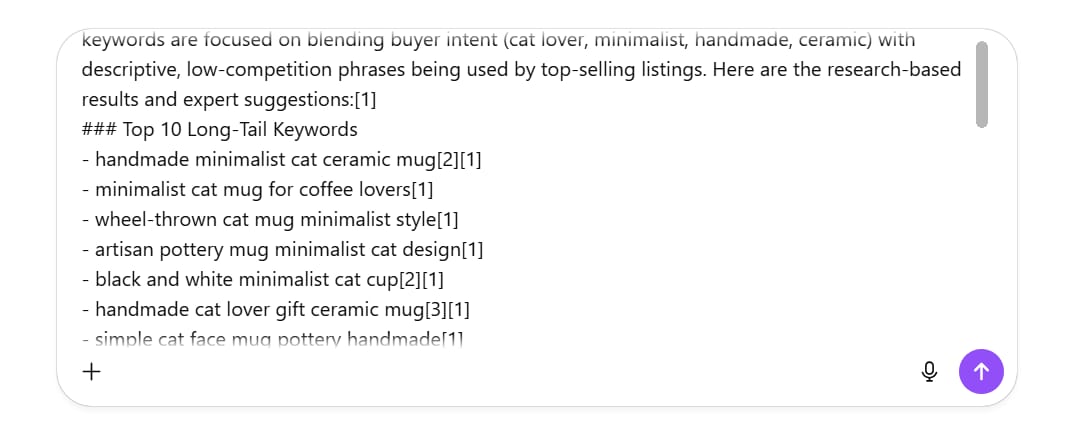
Use the prompt:
"Using the attached keyword report, write 5 different product titles and a 200-word product description for my 'handmade ceramic mug with a minimalist cat design'. Make sure to naturally include the most important keywords. Also, suggest 13 relevant tags for the Etsy listing."
Natural Writing with Claude:
Copy the technical content generated by ChatGPT.
Use this prompt in Claude: "Here is a product description and some titles created by an AI for an Etsy listing. Please rewrite them to sound more human, warm, and persuasive. Focus on telling a story about the product and connecting with a cat lover. Keep the important keywords but make the text flow more naturally."


Creating Custom Workflows for Other Platforms
Since every platform's algorithm is different, ask ChatGPT to create a unique workflow:

"Create a custom AI optimization workflow for a YouTube Shorts channel that focuses on 1-minute cooking tips. The workflow should cover idea generation, scriptwriting, title creation, and description optimization to maximize visibility with the YouTube Shorts algorithm."Then, use Perplexity to research the best current tools for each step in that workflow.
Example Results:


By using this three-tool approach (Perplexity + ChatGPT + Claude), the creator got their first two Etsy sales within just two weeks of launching their store.
Step 4: Build Professional Branding With AI
Your branding makes the difference between looking like an amateur and a professional business. Here is an effective three-tool system for building a memorable brand identity.
Essential Tool - Canva (Cannot Be Replaced):
Canva is the only tool with pre-made templates for every major platform. They offer a generous 30-day free trial of their Pro version.
Why Canva is Essential:

Pre-made templates for YouTube channels, Etsy stores, Instagram posts, TikTok videos, etc.
AI-powered design suggestions.
A massive library of graphics and fonts.
Templates are perfectly sized for each platform.
Example Process:
Choose your platform (e.g., Etsy store banner).
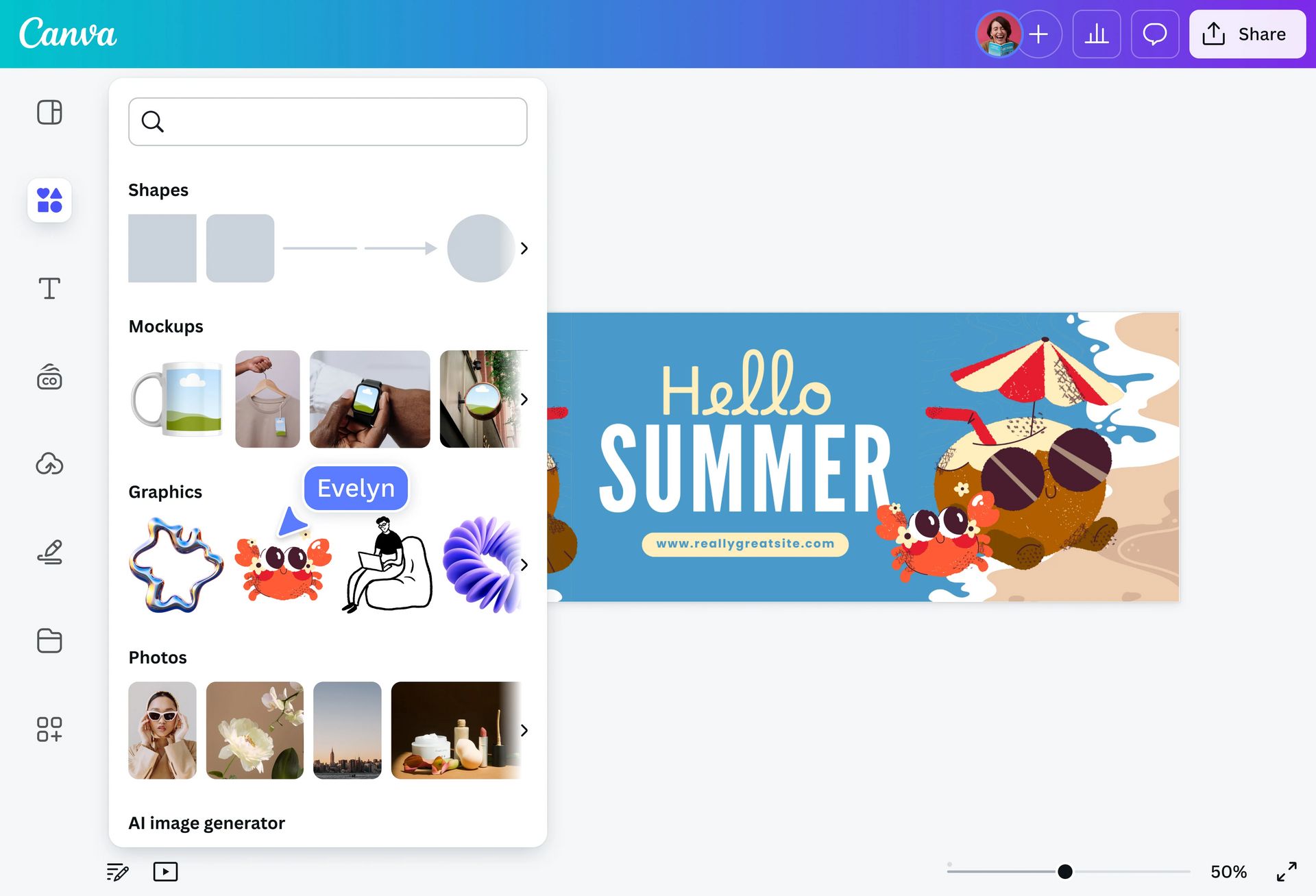
Browse Canva's templates for that platform.
Pick a base design that fits your niche.

Customize the colors, text, and images to match your brand.
Flexible Tool #1 - Brand Name Creation:
You can use any AI assistant for this - ChatGPT, Gemini, or Claude all work well. They are all capable of:
Creating catchy business names.
Writing taglines and slogans.
Developing brand messaging.
Example Prompts:
"Generate 10 memorable and available domain names for a print-on-demand store selling breed-specific dog clothing. The names should be playful and easy to remember."

"Write 5 short, catchy taglines for a business that sells educational AI books for children. The taglines should spark curiosity and trust in parents."

Flexible Tool #2 - Custom Graphics (Optional):
If you want a custom logo or unique images:
Paid Option - Midjourney:

A favorite of the creator in the story.
Produces high-quality and consistent results.
Best for creating professional-looking graphics.
Requires a paid subscription.
Free Option - Leonardo AI:

Provides a daily allowance of free credits.
Currently one of the best free AI image generators.
Good enough quality for getting started.
Image Editing Options:
ChatGPT Method:

Upload your image.
Describe the changes you want.
Get AI-edited results.
Best for simple, text-based edits.
Canva Method:

Manual editing with AI-enhanced tools.
Background remover tool.
Color adjustments.
More control over the final result.
Pro Tip: Start with Canva templates and free tools. Only upgrade to paid options after you're making consistent sales.
Step 5: Scale And Maximize Profits with AI Analytics
Most people use AI for simple tasks, but its real power comes from using it for high-level business analysis. Think of AI as your personal chief financial officer (CFO).
When to Use This System:
Once you have enough sales data (at least a few weeks of activity), you can start using AI to identify growth opportunities.
The Complete Analytics Workflow:
Tool 1 - Zebra AI (Data Visualization):

Zebra AI allows you to upload any business data (sales, website analytics, etc.).
It automatically creates easy-to-understand graphs.
It helps you visually spot trends and patterns.
It quickly identifies strengths and weaknesses.
Tool 2 - ChatGPT with Advanced Data Analysis Mode:

Available on most account types (including free).
This mode spends much more time analyzing data than standard ChatGPT.
It creates detailed, CFO-style business reports.
It takes about 2-3 minutes to generate a comprehensive analysis.
Process:
Upload your data and any questions you have after reviewing it on Zebra AI.
Request a detailed business analysis report. Use a prompt like: "Attached is a CSV file of my Etsy sales for the last 3 months. Act as a business analyst. Analyze this data and provide a detailed report that includes: 1. My top 3 best-selling products and why they might be successful. 2. My 3 worst-selling products and potential reasons for their failure. 3. Any sales trends related to time of month or specific designs. 4. Three actionable recommendations to increase my overall profit for the next quarter."

Copy the complete report for the next step.

Tool 3 - Google NotebookLM (Enhanced Learning):
Upload ChatGPT's report to Google NotebookLM.

This tool converts complex data into simple learning tools.
It creates visual mind maps of your business insights.

It generates AI podcast discussions about your data.
The AI Podcast Feature:
This is a truly game-changing feature. NotebookLM creates a natural conversation between two AI "hosts" discussing your business data. You can listen while doing other tasks.
An example snippet from a real AI podcast:
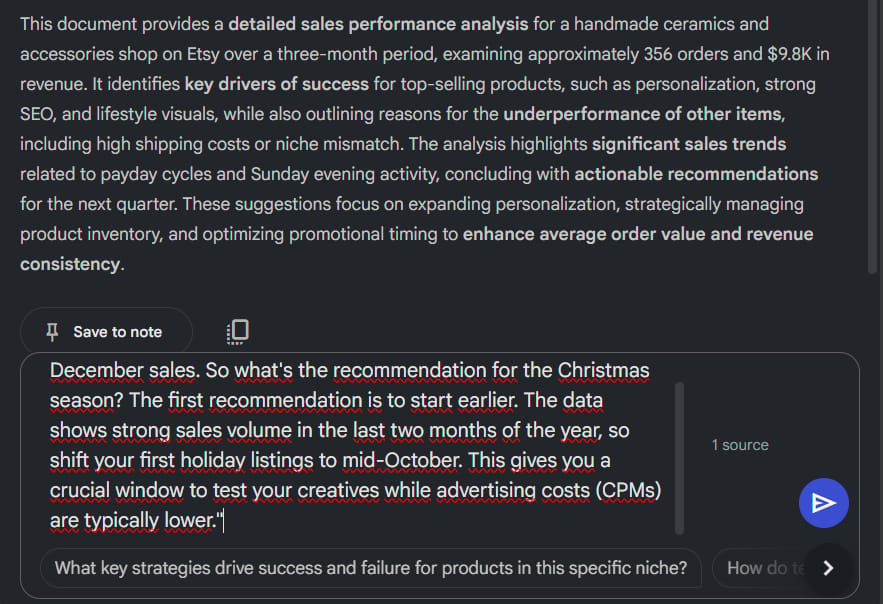
"Based on the report, there's a notable point about November and December sales. So what's the recommendation for the Christmas season? The first recommendation is to start earlier. The data shows strong sales volume in the last two months of the year, so shift your first holiday listings to mid-October. This gives you a crucial window to test your creatives while advertising costs (CPMs) are typically lower."Why This System Works:
Instead of staring at spreadsheets, you get:

Visual graphs showing exactly what's happening.
Professional business analysis you'd normally pay a consultant for.
Easy-to-understand explanations of complex data.
Actionable recommendations to increase profits.
The ability to "study" your business insights while multitasking.
Real Results:
Using this system, you can identify specific opportunities like:

The best times to launch seasonal products.
Which designs are most profitable.
When to start holiday marketing campaigns.
Pricing optimization opportunities.
Customer behavior patterns.
Conclusion: Your Path To AI Business Success
Building a profitable one-person AI business isn't about using the newest, flashiest tools. It's about solving real problems with proven systems that actually work.
What makes this approach different:
It's based on a real business that is generating substantial income.
Every tool and workflow has been tested and proven.
You're not competing by copying others, but by creating your own value.
The focus is on sustainable, growing profits.
Your Next Steps:
Start with Step 1: Use AI to help you identify a genuine market gap you can fill.
Design Your Workflow: Map out the specific tools you'll need for your business idea.
Choose Your Platform: Pick a place where your ideal customers already spend their time.
Create Professional Branding: Use Canva's templates to look established from day one.
Plan for Growth: Set up your analytics workflow as soon as you have initial data.
Remember: The creator in the story got their first sales within two weeks using these exact methods. Your timeline might be different, but the system works when you follow it consistently.
The AI business opportunity is real, but only if you approach it strategically. Stop looking for shortcuts and start building something that solves actual problems for real people.
If you are interested in other topics and how AI is transforming different aspects of our lives or even in making money using AI with more detailed, step-by-step guidance, you can find our other articles here:
How well did this guide cover the topic of "making money with AI"? |
Reply